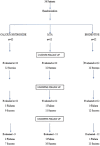Comparison of three different materials used for indirect pulp capping in permanent molars: An in vivo study
- PMID: 35722078
- PMCID: PMC9200191
- DOI: 10.4103/jcd.jcd_551_21
Comparison of three different materials used for indirect pulp capping in permanent molars: An in vivo study
Abstract
Background: Pulp capping should always be considered as the primary treatment of choice for teeth without irreversible pulpitis in lesions approaching dental pulp. The predictability of vital pulp therapy has improved with the introduction of newer bioceramic materials.
Aim: The aim of this study was to evaluate the clinical success of Biodentine, calcium hydroxide (CH), and mineral trioxide aggregate (MTA) as pulp capping materials for indirect pulp capping in carious permanent teeth.
Materials and methods: Indirect pulp capping was done for 36 molars of 36 patients with deep caries lesions. They were randomly divided into three groups: Biodentine group (12 teeth), MTA group (12 teeth), and CH group (12 teeth). Patients were recalled at 1, 3, and 6 months to evaluate the clinical success of the treatment outcome.
Statistical analysis: All statistical analysis was performed using SPSS software version 21.0. Pearson's Chi-square test was used to compare the success and failure rates between Biodentine, MTA, and Ca(OH)2 at three different time intervals (30, 90, and 180 days) and also the overall success and failure rates between Biodentine, MTA, and Ca(OH)2 irrespective of the time intervals. P < 0.05 was considered statistically significant.
Results: In a statistical trial/study, the pulp capping materials gave different success rates, 91.67% success in the Biodentine group, 83.33% success in the MTA group, and 58.33% success in the CH group. The results were not statistically significant.
Conclusion: Indirect pulp capping with calcium silicate materials provided better results compared to that of calcium hydroxide.
Keywords: Biodentine; calcium hydroxide; indirect pulp capping; mineral trioxide aggregate.
Copyright: © 2022 Journal of Conservative Dentistry.
Conflict of interest statement
There are no conflicts of interest.
Figures
References
-
- Miyashita H, Worthington HV, Qualtrough A, Plasschaert A. Pulp management for caries in adults: Maintaining pulp vitality. Cochrane Database Syst Rev. 2007;(2):CD004484. - PubMed
-
- Leksell E, Ridell K, Cvek M, Mejàre I. Pulp exposure after stepwise versus direct complete excavation of deep carious lesions in young posterior permanent teeth. Endod Dent Traumatol. 1996;12:192–6. - PubMed
-
- Lee SJ, Monsef M, Torabinejad M. Sealing ability of a mineral trioxide aggregate for repair of lateral root perforations. J Endod. 1993;19:541–4. - PubMed
-
- Bjørndal L, Reit C, Bruun G, Markvart M, Kjaeldgaard M, Näsman P, et al. Treatment of deep caries lesions in adults: Randomized clinical trials comparing stepwise vs. direct complete excavation, and direct pulp capping vs. partial pulpotomy. Eur J Oral Sci. 2010;118:290–7. - PubMed
-
- Browning WD. Critical appraisal.2015 update: Approaches to caries removal. J Esthet Restor Dent. 2015;27:383–96. - PubMed
LinkOut - more resources
Full Text Sources

